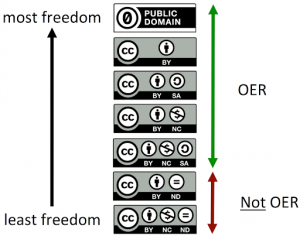Private: Creating and Sharing OER
8 The Basics
This unit will explore practices of creating and sharing OER so they can have the biggest impact and be used without any legal or technical barriers.[1]
Why It Matters
A big part of any educator’s work is preparing, updating, and combining learning materials. Making those materials open requires just a few additional steps, and it’s easier than you think. What are those steps? What should you consider and expect when you want to create and publish your resources in the open?
When we share our education resources as OER, we share our best practices, our expertise, our challenges and solutions. Education is about sharing. When we share our work with more people, we become better educators.
Personal Reflection: Why It Matters To You
What kind of learning resources do you create now? Are you already publishing and sharing these resources with others for feedback? Which of your resources do you think could benefit fellow educators, learners, libraries or scientists? If you choose to share, how much freedom do you give to others to reuse or borrow from your work; what permissions will you allow for others to reuse your work?
Why share?
For an introduction on why it is important to share your work as OER, watch this video (time 03:51):
Because educators and librarians can share OER with everyone for near zero cost[2], we should. After all, education is fundamentally about sharing knowledge and ideas. Libraries are about archiving, sharing, and helping learners find the knowledge they seek. When we license our work and resources under a Creative Commons license, we are sharing that work with the public under simple, legal permissions. Sharing your work expressly with the intention for others to use and share, is a great service and gift to the world.
Choosing a CC license for OER
Creative Commons has a suite of six open copyright licenses. Creative Commons fully support authors’ selection and use of any of the CC licenses or public domain tools. However, not all education materials available under a CC license are true OER. Some CC licenses are more restrictive than others in how they’re created and shared. Review this chart that details which CC licenses work well for education resources and which do not.

The two CC No Derivatives (ND) licenses are not technically OER-compatible licenses because they do not allow the public to revise or remix the education resource. Because the ND licenses do not meet the 5Rs or any of the major OER definitions, the open education movement does not consider ND-licensed education resources “OER”. That said, there are legitimate reasons for not wanting to allow derivatives of your work. The OpenHawks program does allow for ND-licensing on resources created by its grantees, but we ask that you apply these licenses only if you truly want your work to be reused only as-is.
Choosing the right license for your OER requires you to think about which permissions you want to give other users – and which permissions you want to retain for yourself. Read the “Open Textbook Community Advocates CC BY License for Open Textbooks” and think about why they recommend the Creative Commons Attribution License (CC BY) for education. You can find similar text with more arguments made about this same license for publishing scientific research in “Why CC BY?” from Open Access Scholarly Publishers Association.
For basic information about applying a license to your work or others’ work, visit UI Libraries’ OER guide or get started right away and learn how to choose and apply a license with the application tool from Creative Commons.
Other considerations
Other than choosing the right CC license, consider other aspects of “openness” such as best teaching practices using OER in the classroom, pedagogical implications of student learning, and assessment of how OER impacts student learning. Here is a list of best practices to include in your work when building OER.
For more practical advice on how to share OER online and prepare OER to be used offline, as well see the Open Washington Module 8 on “Sharing OER.”
Ensuring OER is accessible to everyone
At its core, OER is about making sure everyone has access. Not just rich people, not just people who can see or hear, not just people who can read English, not just people who have digital devices with access to high speed internet – everyone!
As authors and institutions build and share OER, best practices in accessibility need to be part of the instructional and technical design from the start. Educators have legal and ethical responsibilities to ensure our learning resources are fully accessible to all learners, including those with disabilities.
Best practices to ensure your OER is accessible to all include:
- putting your work into the public domain (CC0) or adding a non-ND CC license to your work,
- make it simple to download your work in editable file formats, so others can modify and/or translate it to meet local needs and make it accessible, and
- most important – design your work to be accessible from the start.
You can learn more about accessibility for OER in the Accessibility section of this text.
Final remarks
Openness in education means more than just access or legal certainty over what you are able to use, modify, and share with your learners. Open education means designing content and practices that ensure everyone can actively participate and contribute to the sum of all human knowledge. As educators and learners revise others’ OER and create and share new OER, accessibility should always be on your design checklist.
- This chapter is adapted from The Creative Commons' CC Certificate Resources, Chapter 5: Creative Commons For Educators, published under a Creative Commons Attribution 4.0 International License. ↵
- While in many other countries (like in many EU member states), cost may not be a problem, restrictive copyright and narrow fair use / fair dealing rights can limit new teaching methods. ↵

